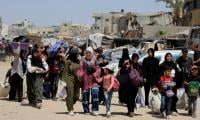COP-28 started with a great pump and show. The UAE, president of COP-28, announced a $30 billion climate investment. The world community built a consensus to launch the Loss and Damage Fund to compensate more vulnerable countries to climate change disasters. Pakistan played a leading role in finalising the Fund, which was well-recognised.
Global leaders, experts, scientists and activists are gathering in Dubai to attend the COP-28. They will discuss how international community can join hands to combat climate change. Like every year, they will talk about a wide range of areas for cooperation and action. Education is one of them.
Education has been mentioned almost 32 times in the formal agenda of UNFCCC till COP-27. Since COP-27, UNFCCC and the world community have shown more interest in taking education seriously. Initiatives like Green Education Partnership by Unesco and partners are further strengthening the focus on education.
The data and reports indicate education is one of the most vulnerable sectors to climate change. The impacts of climate change on the education system are multifaceted. Education infrastructure is highly susceptible to disasters like floods, droughts, heat waves, etc. We have seen many times floods wreaking havoc with education infrastructure – damaged or destroyed schools, colleges, universities and education delivery systems.
During the flood of 2022 in Pakistan, more than 34,000 schools were damaged or destroyed. Over 3.5 million children were affected by the floods, and 672,000 children needed urgent support. It was observed girls had to face the worst consequences.
During the floods, more than 7,000 schools were used as temporary shelters. The initial estimate showed Pakistan needed $10.2 million to meet the urgent needs. Unicef Pakistan tried to help the communities and bridge the financial gap but with limited success. Unicef has also launched programmes to build young people’s capacity. However, the problem is so huge it is beyond Unicef’s capacity to tackle it independently. They need more resources and partners.
The education sector is also largely exposed to indirect impacts of climate change. For example, families who lost their productive resources or livelihood opportunities have to compromise on spending. Children’s education is one of the prime targets. Moreover, the impacts of disasters on food system enhance food insecurity, which increases the risk of kids dropping out of school.
Climate change impacts on health also play a leading role in determining the fate of children’s education. We have observed climate change enhancing the frequency of malaria, dengue and other diseases.
Further, it has been predicted disease vectors like mosquitoes will become more active in spreading the disease. The challenge of waterborne disease has also become severe. On the other hand, indirect implications of climate change on health through heat waves, wildfires, floods, tropical storms and hurricanes are becoming more serious. Children’s weak immunity makes them highly vulnerable to health risks.
Climate change will also be a source of forced migration. It is common knowledge disasters like floods cause internal displacement of people. On the other hand, long-term impacts force people to migrate in search of better places. For example, sea intrusion in coastal areas causes people to migrate, like Badin in Pakistan. It is and will be impacting children’s education.
It is anticipated impacts on education will introduce deep-rooted challenges on multiple fronts. The disasters will not only destroy the hard infrastructure, but will also erode capacity to combat climate change. It will directly hit the capability of countries to produce quality human capital. As we know, education and health are the key ingredients for developing human capital. Thus, any impact on education will negatively affect formation of human capital. The literature review on the relationship between climate change-induced disruption in education provision and human capital creation reinforces the argument.
Disruption in creation of human capital will have severe implications on economic growth and development. The quality of human capital directly affects the pace of economic growth and development. Economic literature suggests human capital helps maintain or accelerate growth by improving efficiency, innovation, etc.
Second, education is vital to building capacity and capability of the world to mitigate, adapt and be resilient to climate change. Educated societies will be better positioned to face challenges and convert them into opportunities. It will allow them to venture into new fields and develop innovative ways and technologies. Rather, they are already venturing into new energy markets like solar, hydrogen, nuclear, etc. They are developing new solutions to lower GHG emissions, like electric vehicles, environment-friendly housing, green production systems, etc.
Moreover, education will help resource-poor, developing countries and marginalised communities build resilience. Education will allow them to build capacity according to their need. With the newly-acquired skills, they will be better positioned to adapt or mitigate climate change, innovating mechanisms or practices to tackle climate change through their knowledge. Further, educated people will bring new financial resources to their families and society. These actions will help lower the vulnerability.
The world needs an education system that can absorb climate change shocks and continue producing quality human capital. It is satisfactory to note the world is cognizant of the importance of education to combat climate change. Many global organisations like Unicef and Unesco are launching education-specific initiatives. However, there is a need to expand the focus and introduce a whole system approach. It can help solve many problems by focusing on following areas.
There is a need to build climate change-resilient education infrastructure like schools, colleges and universities. It will help countries not only keep the institutions working but also help shield them against financial losses. The world should focus on innovative technologies that can help maintain connectivity during disasters. The technologies should be used to ensure continuity of education during disasters. Work should be started on the immune systems of children and youth to combat climate change-related health challenges, especially against unknown diseases. It is vital because climate change can introduce new diseases.
There is also a need to build green education infrastructure and lower emissions from the education sector. Educational institutes can use renewable energy for lighting and heating. They can also convert their transport system into renewable-powered vehicles. It is good to note Green Education Partnership is doing decent work to make it happen.
The question is from where we will get financial resources, and who will take the lead in creating a model of a climate-compatible education system for the world. For that purpose, the world will have to adopt a comprehensive approach and work to build permanent sources.
An international organisation on the climate-compatible education system should be created under the UN system. This must be a joint venture of UNFCCC, UNEP, Unicef, Unesco, etc. There should be an international fund. All the countries must support it, and contribute resources according to historical responsibility and equity principles. The fund can also explore the carbon credit market by greening the education system. It will help ensure sustainability of the fund.
Who will lead to the development of a model? The prevailing situation suggests China can be a perfect choice. As an emerging responsible global power, China is championing the green agenda and has the financial resources to materialise it into reality. Moreover, China is promoting the vision of a community with a shared future. It would be easier for it to build and share the model with the world.
It is the right time to build a climate-compatible education system, as the world cannot waste time anymore. A weak education system will affect the world’s ability to develop capacity and capability to combat climate change. The world should join hands for the purpose.
Gohar Ijaz says burden of negligence of government departments in the IPPs case was being put on the public
The discussions focused on significant strides made by Pakistan in improving its macroeconomic indicators by focused...
A single bench, comprising Justice Tariq Saleem Sheikh, heard petition filed by wife of PTI founder
Co-curricular activities regarding August 14 celebrations shall continue in letter and spirit
At beginning of hearing at 10 o'clock, lawyers were not present in court
Admiral Naveed Ashraf expresses confidence that induction of these highly adaptive platforms will further enhance...







